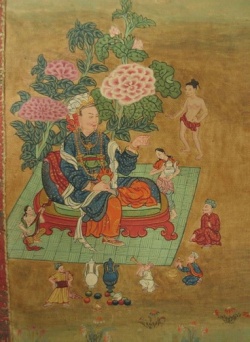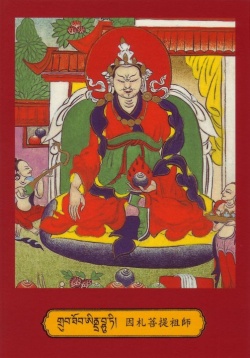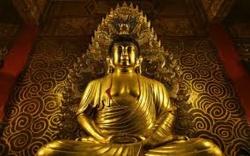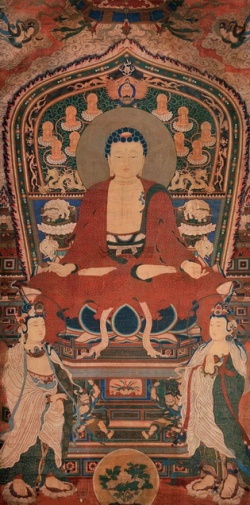Indrabhuti
Indrabhuti (Skt. Indrabhūti, Tib. རྒྱལ་པོ་ཨིནྡྲ་བྷུ་ཏི་) aka Indrabodhi, can refer to several kings from Oddiyana or Zahor who were key figures in the early transmission of the Vajrayana teachings:
- Indrabhuti the Great or Elder (Tib. ཨིནྡྲ་བྷུ་ཏི་ཆེན་པོ་, Wyl. i n+dra b+hu ti chen po)
- Indrabhuti the Intermediate or Second (Tib. ཨིནྡྲ་བྷུ་ཏི་བར་པ་, Wyl. i n+dra b+hu ti bar pa)
- Indrabhuti the Younger (Tib. ཨིནྡྲ་བྷུ་ཏི་ཅུང་པ་, Wyl. i n+dra b+hu ti chung ba or ཨིནྡྲ་བྷུ་ཏི་ཆེན་པོ་སྲས་, i n+dra b+hu ti chen po'i sras), aka Lawapa, Kambalapāda, or Shakraputra — the son of Indrabhuti the Great
- Indrabhuti, the King of Oddiyana, who was the adoptive father of Padmasambhava.
King Dza or Ja (Tib. རྒྱལ་པོ་ཛ་, Wyl. rgyal po dza) of Zahor, the first human recipient of the Mahayoga teachings as well as an important figure in the transmission of Anuyoga, has been varyingly identified with either one of the first three Indrabhutis.
Dudjom Rinpoche writes:
- Some say that King Ja was none other than Indrabhuti the Great, who had been empowered by [Buddha Shakyamuni] himself, but others maintain that he was Indrabhuti's son. Some even believe him to have been [Indrabhuti the Intermediate].
Thus, there are various dissimilar opinions; but, because ordinary persons cannot imagine the emanations of great sublime beings, perhaps they are all correct!
And yet, upon examination of the chronology, we find he is described as a contemporary of master Kukkuraja.
For this reason, he may well be an intermediate Indrabhuti.
Moreover, the great accomplished master Kambalapada and this king are contemporary, whether or not they are in fact one and the same person. He is also the approximate contemporary of Vidyavajra, Saroruha, and Jalandharipa.[1]
Footnotes
- ↑ Dudjom Rinpoche, The Nyingma School of Tibetan Buddhism (Boston: Wisdom Publications, 1991), pages 458-459.
Further Reading
- Nathan Katz, 'A Translation of the Biography of the Mahāsiddha Indrabhūti, with Notes' in Bulletin of Tibetology, vol. 12, no. 1 (1975), pp. 25-29.
Source
Indrabuti (alternatively King Ja) is a name attributed to a number of individuals that have become conflated in the esoteric Buddhadharma tradition of Mantrayana.
Karmay (1981) opens the peer-review discourse in identifying the different personages.
One Indrabhuti, considered a Mahasiddha, was a disciple of Lawapa.
The matter of the conflation of Indrabhuti and at least one evocation of the historicity of a particular personage by that name is intimately connected with the location of 'Oddiyana' (the locality denoted by the term 'Oddiyana' whether in each case cited is Swat Valley or
Orissa or some other location is glossed with a suite of orthographic representations and near homophones which require further case-by-case examination and exploration),
Orissa and the cult of Jaganath and a number of texts that inform the matter such as the Sādhanamālā' , Kālikā Purāṇa, Caturāsiti-siddha-Pravṛtti, Jñānasiddhi as Donaldson (2001: p. 11) frames an overview of some of the debate and then ventures further salience:
(1) O-rgyān, U-rgyān, O-ḍi-yā-na, and (2) O-ḍi-vi-śā, with the first series connected with Indrabhūti, i.e., Oḍiyăna and Uḍḍiyāna, while the second series falls back on Oḍi and Oḍiviśa, i.e., Uḍra (Orissa) and has nothing to do with Indrabhūti.
N.K. Sahu objects, however, and points out that these two sets of names are seldom distinguished in Buddhist Tantra literature, and opines that the words Oḍa, Oḍra, Uḍra, Oḍiviśa and Oḍiyāna are all used as variants of Uḍḍiyāna.
In the Sādhanamālā, he further points out, Uḍḍiyāna is also spelt as Oḍrayāna while in the Kālikā Purāṇa, as indicated earlier, it is spelt either Uḍḍiyāna or Oḍra.
There is also evidence, Sahu continues, that Indrabhūti is the king of Orissa rather than of the Swāt valley.
The Caturāsiti-siddha-Pravṛtti, for example, mentions him as the king of Oḍiviśa while Cordier, in his Bṣtān-ḥgyur catalogue, gives sufficient indications of his being the king of Orissa.
Also, in his famous work Jñānasiddhi, king Indrabhūti opens it with an invocation to Lord Jagannātha, a deity intimately associated with Orissa and with no other area of India.
King Ja, receiver of gifts from the sky
According to Nyingma tradition, King Ja (also known as Indrabhuti) taught himself intuitively from "the Book" of the Tantric Way of Secret Mantra (that is Mantrayana) that magically fell from the sky along with other sacred objects and relics "upon the roof of King Ja" according to Dudjom (1904–1987), et al. (1991: p. 613
History) this happened on the Tibetan calendar year of the Earth Monkey, which Dudjom et al. identify as 853 BC King Ja taught Kukuraja, the "Dog King", from "the Book."
This date of 853 BC[E] is problematic as it puts the event prior to the dates of the historical Buddha Shakyamuni circa 500 BCE as well as prior to the emergence of Tantra in any of its historical permutations according to modern Western peer-reviewed scholarship bar the lineages of the Bonpo (the dates are according to Bonpo tradition which are contended with) which not 'officially' tantric have many elements akin to tantra traditions.
Moreover, it should be stated that the falling of Buddhadharma relics upon a Tibetan royal palace also happened in the case of Thothori Nyantsen and these two stories (i.e. the story of Thothori Nyantsen and the narrative of King Ja) may have influenced each other as they share a distinctive motif of magical realism.
Dudjom (1904–1987), et al. (1991: p. 460 History) also include another important source that impacts on this story of King Ja and salient dates for the greater tantric tradition, particularly the dating of the emergence of the texts of Anuyoga with the provision of a quote of what Dudjom et al.
identify as a "prediction" found in the fifth chapter of the 'Tantra which Comprises the Supreme Path of the Means which Clearly Reveal All-Positive Pristine Cognition' (Wylie: kun bzang ye shes gsal bar ston pa'i thabs kyi lam mchog 'dus pa'i rgyud, Nyingma Gyubum Vol.3) which Dudjom, et al., render in English thus:
- The Mahayoga tantras will fall onto the palace of King Ja. The Anuyoga tantras will emerge in the forests of Singhala (Dudjom et al. identify Singhala as located in Ceylon).
Indrabhuti, at the time of Tilopa, disciple of Kambalapada
Choudhury (2007: p. 6) states in relation to Indrabhuti who was the disciple of Kambalapada (fl. 10th century):
- The Sidhacharyas popularised the tenets of vajrayana by composing numerous texts. Indrabhuti, disciple of the saint Kambalapada, created a sensation by composing his famous treatise 'yajnasidhi'.
Indrabhuti learned of 'insight' (Sanskrit: prajñā) though the instruction of Tilopa (988–1069 CE).
Source
Although it is generally accepted that Tantric Buddhism first developed in the country of Uddiyana or Odra Desha under King Indrabhuti, there is an old and well known scholarly dispute as to whether Uddiyana or Odra was in the Swat valley, Odisha or some other place.
Indrabhuti, the oldest known king of Sambalpur founded Vajrayana while his sister who was married to Yuvaraja Jalendra of Lankapuri (Suvarnapur) founded Sahajayana.
These new Tantric cults of Buddhism introduced Mantra, Mudra and Mandala along with six Tantric Abhicharas (practices): such as
Marana,
Stambhana,
Sammohana,
Vidvesan,
Uchchatana and
Vajikarana.
The Tantric Buddhist sects made efforts to raise the dignity of the lowest of the low of the society to a higher plane. It revived primitive beliefs and practices a simpler and less formal approach to the personal god, a liberal and respectful attitude towards women and denial of caste system.
From the seventh century A.D. onwards many popular religious elements of heterogeneous nature were incorporated into Mahayana Buddhism which finally resulted in the origin of Vajrayana, Kalachakrayana and Sahajayana Tantric Buddhism.
Tantric Buddhism first developed in Uddiyana, a country which was divided into two kingdoms Sambhala and Lankapuri.
Sambhala has been identified with Sambalpur and Lankapuri with Subarnapura (Sonepur).
Many celebrated Vajrayana Acharyas like Sarah, Hadipa, Dombi Heruka, Tantipa and Luipa came from the so-called despised classes.
The cult exerted a tremendous influence over the tribal and despised classes of people of Sambalpur and Bolangir region.
It was in the 9th/10th century A.D. that there appeared seven famous Tantric maidens at Patna (Patnagarh) region which was then called Kuanri-Patana.
These maidens are popularly known as Saat Bhauni (Seven sisters), namely, Gyanadei Maluni, Luhakuti, Luhuruni, Nitei Dhobani, Sukuti Chamaruni, Patrapindhi Savaruni, Gangi Gauduni and sua Teluni.
They hailed from so-called the low castes of the society and were followers of Lakshminkara. Because of their miraculous power and feats; they have been later on deified and worshipped by the folk people.
A systematic analysis of the trend of religious development of the period under review and circumstantial evidences reveal that Chakra Sambar Tantricism of Tantric Buddhism gained popularity in the Gandhagiri region.
The chief deity of Chakra Sambara Tantra is Buddha Sambara, the deity whose worship is still popular in China and Tibet.
According to Sadhanamala, god Buddha Sambara is one-faced and two-armed.
He appears terrible with his garment of tiger-skin, garland of heads, a string of skulls round the head, three eyes and in Âlidhamudrâ, he tramples upon Kalaratri.
A number of texts relating to the procedures of worship of God Buddha Sambara have been composed by siddhacharyas like Darikapa, Santideva, Jayadratha and others.
King Indrabhuti of Shambala (Sambalpur) composed Chakra Sambara Stotra, Chakra Sambara Anubandha Samgraha, Chakra Sambara Tantraraga Sambara Samuchchaya Nama Brutti etc.
The philosopher cum king Indrabhuti became the source inspiration to the adherents of Tantric Buddhist cult in Kosala including Gandhagiri region.
Indrabhuti and Laksminkara, the two royal Buddhist Acharyas created a mass of followers to their cults.
In the 9th–10th century A.D. the worship and sadhana of Buddha Sambara, the presiding deity of Chakra Sambara Tantra gained popularity in the Gandhagiri region.
In Gandhagiri which also contained a large number of caves and rock shelters, apparently of the Vajrayanists and Sahajayanists, the adherents of the cults used to live in seclusion and practice Kaya Sadhana or Yogic practices along with worshipping god Buddha Sambara.
This tantric Buddhist culture greatly affected the religious faith and beliefs of the tribal of Gandhagiri, so much so that eventually even today one can notice the invocation of various Buddhist Siddhacharyas and Buddhist deities in the mantras of the tribal to ward off evil spirits or cure some disease.
It is also interesting to note here that Buddha was worshipped by many tribal in the name of Budharaja. There is also a small hillock at the heart of present day Sambalpur by the name Budharaja.
Kalki & Shambhala
Kalachakra tantra was first taught by the Buddha to King Indrabhuti, the first dharmaraja of Shambhala.
"Lord Kalki will appear in the home of the most eminent brahmin of Shambhala village, the great souls Vishnuyasha and Sumati." (Srimad-Bhagavatam Bhag.12.2.18)



